Latest Posts
As part of their public history class, DePaul University students Anne Crowe, Patrick Elliott, Joshua Khalilian, and Andrea Weiss-Tracy explore the life and work of Chicago artist Trinidad Castillo in this blog post. The Chicago History Museum commissioned Castillo to paint a mural for its exhibition American Medina: Stories of Muslim Chicago. The students’ course was taught by Peter T. Alter, the Museum’s chief historian, director of the Studs Terkel Center for Oral History, and curator of American Medina.
Native Chicagoan Trinidad Castillo is an artist with a love of letters and calligraphy whose work is often rooted in his Islamic faith. He grew up in Horner Park, which is part of the North Center community area, and later moved to the Southwest Side.
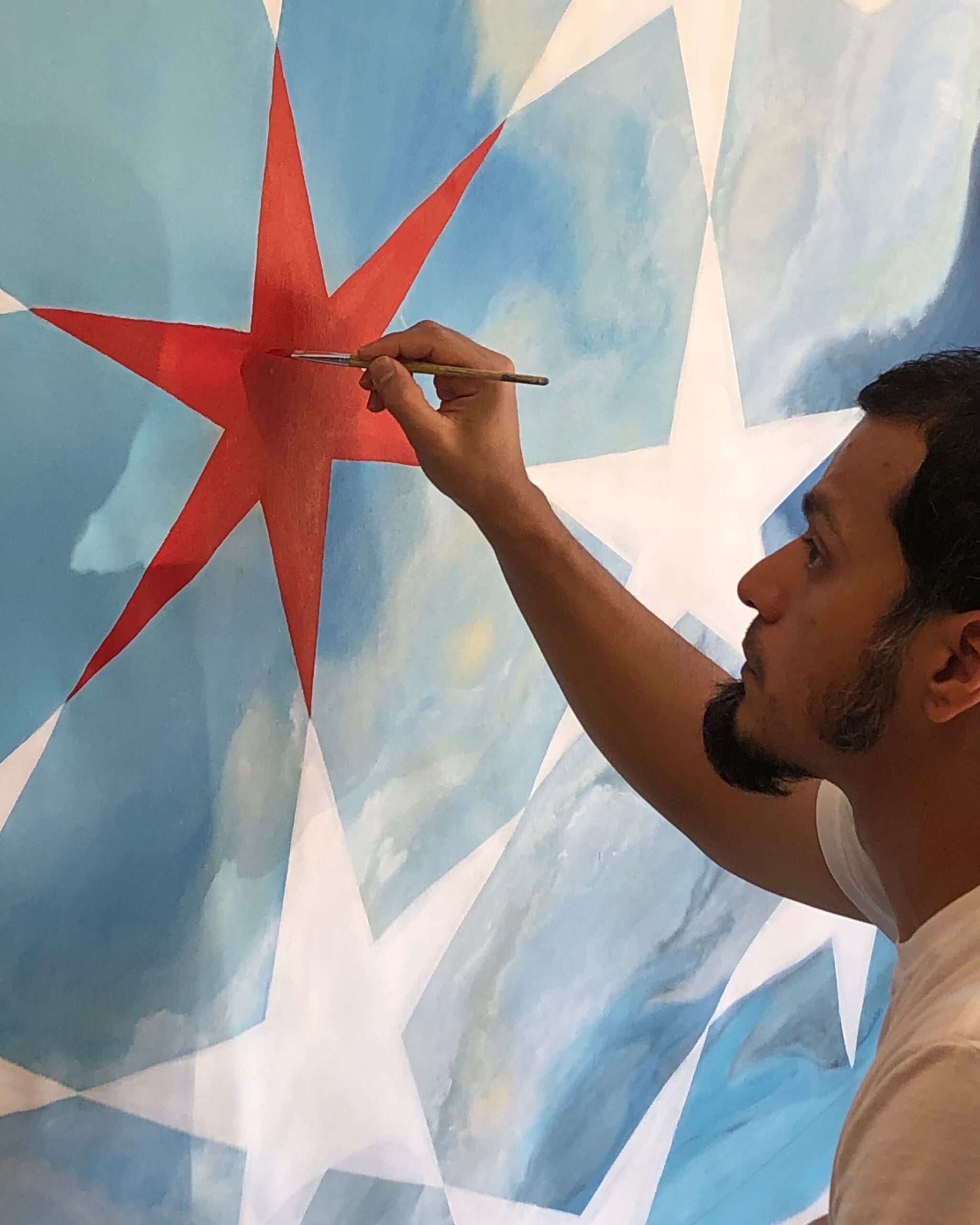
Trinidad Castillo paints his mural for American Medina. Photograph courtesy of Castillo
As a youth in the 1990s, Castillo attended arts programs at the Southwest Youth Collaborative (SWYC), a local community organization that no longer exists. At SWYC, he became deeply rooted in hip-hop culture, art, and the history of the Southwest Side. In these programs, he learned “how to make the community beautiful” through art and use that art to “celebrate what we look like as a community.”
Castillo later returned to SWYC to work as a youth programs coordinator, leading break dancing and mural arts initiatives. His spiritual journey began after he developed a deep connection with a Muslim coworker. This friendship greatly inspired him, driving him to learn more about the faith, and eventually leading to his conversion.
In the 2010s, shortly after his conversion, Castillo and two other SWYC representatives visited Palestine on the Hip-Hop Bus Stop Tour, giving performances and leading workshops for Palestinian youth. He found the entire experience eye-opening as he saw the “hard truth,” witnessing disheartening situations of poverty and pain in Palestine. Castillo also began to develop his love for Arabic calligraphy while there.
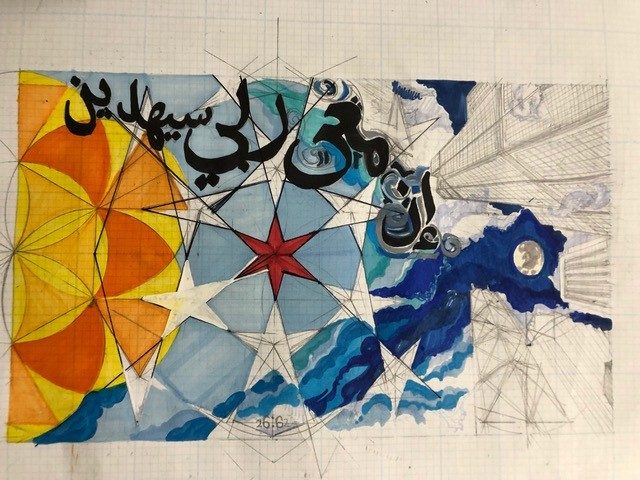
Castillo’s sketch for his mural, which incorporates traditional Islamic elements with ones that are distinctly Chicago, such as the six-pointed star from its flag and the skyline. Photograph courtesy of Castillo
The Chicago Muslim Oral History Project is the foundation for the American Medina exhibition, with roughly 150 interviews conducted to date and about forty of those featured in the exhibition. Eventually, all interview audio and transcripts will be available through the Museum’s website. In the fall of 2019, project curatorial assistant Mona Askar conducted an oral history interview with Castillo.
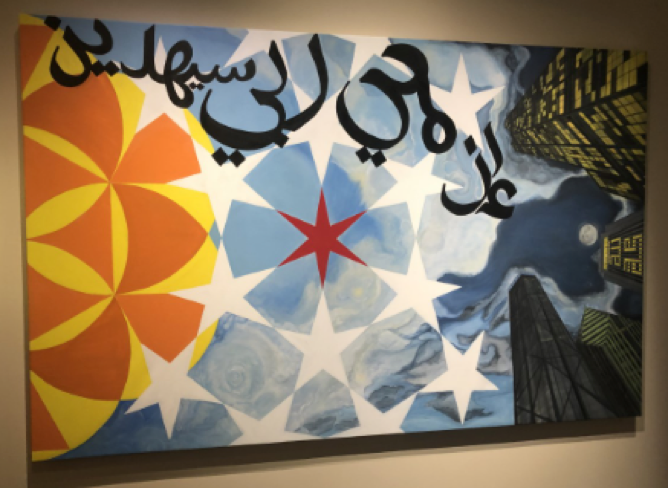
Castillo’s finished work, American Medina. Image by CHM staff
During the interview, he described how he embraced the use of Islamic-inspired geometric patterns in the American Medina mural. These “geometric subgrids,” he told Askar, “flourish from the basics of the circle.” Castillo also incorporated verse sixty-two of the Ash-Shu’arâ’ chapter of the Quran, the holy book of Islam. Translated from the original Arabic, it reads “Surely my Lord is with me and He will guide me through.” The Prophet Moses said this to his followers as they fled from the Egyptian pharaoh’s army, and to Castillo, this verse means that his faith will guide him through his life in Chicago. Through this mural and his personal journeys, Castillo illustrates how his faith and life experiences have influenced his artistic and religious identities in Chicago, the American Medina.
Additional Resources
For Asian Pacific American Heritage Month, we’re highlighting the work of Junnosuke “Jun” Fujita, a photojournalist, poet, and silent film actor.
Born near Hiroshima in 1888, Fujita came to Chicago in 1909, becoming the first Japanese American photojournalist in the United States and achieving unprecedented success despite having to endure prejudice, bigotry, and hostility. He worked for the Chicago Evening Post and the Chicago Daily News, documenting major Chicago events in the early twentieth century such as the Eastland Disaster (1915), the 1919 race riots, and the aftermath of the St. Valentine’s Day Massacre (1929).
A selection of his images are in our collection and can be viewed at CHM Images, our online portal. Some images are graphic in nature; viewer discretion advised.
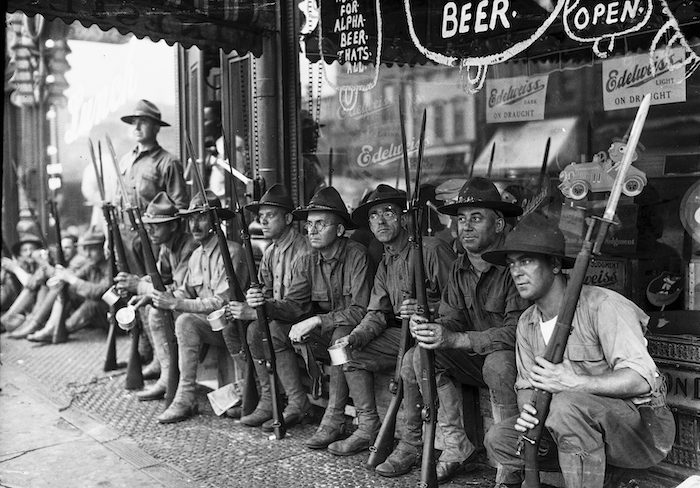
Illinois National Guard sitting in front of a storefront during the race riots, Chicago, 1919. CHM, ICHi-065489; Jun Fujita, photographer
You can peruse thousands of digitized prints and photographs at CHM Images, our online portal. Featured galleries include images from our newly acquired Chicago Sun-Times Photography Collection, Raeburn Flerlage’s work documenting the Chicago blues and folk music scene during the 1950s–1970s, and Declan Haun’s photography capturing the American Civil Rights Era.
We encourage the use of our images for a variety of personal, nonprofit, and commercial purposes and all proceeds support the Chicago History Museum and our mission to share Chicago stories.
Blues Music Comes to Chicago
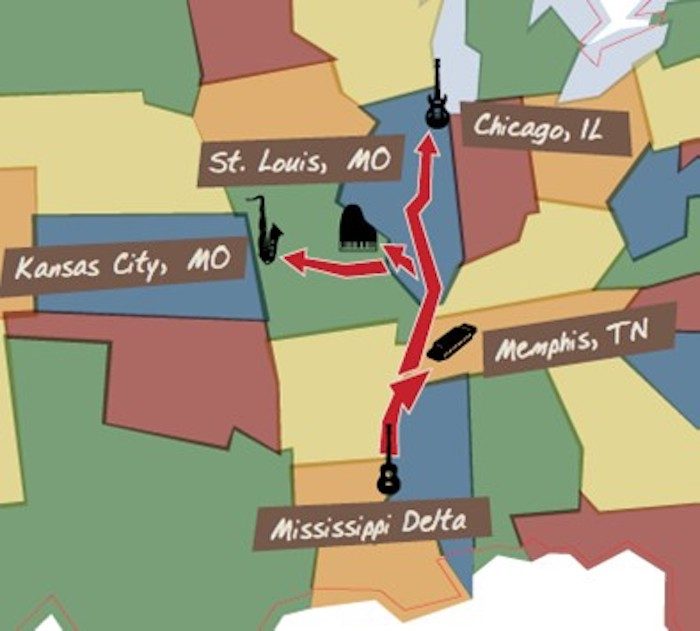
Eleven-year-old Penny and her family are part of the Great Migration, moving from Mississippi to Chicago. Their first day in the city is full of new sights and sounds and meeting extended family members. Read or listen to A Bronzeville Story, then make a scrapbook page of Penny’s first day in Chicago. Share all of your creations on social media using the hashtag #CHMatHomeFamilies
Blues Biographies

Meet some famous Chicago blues artists and match their stage name to their biography. Then use our fun name generator to choose your own stage name and make a backstage pass! Share all of your creations on social media using the hashtag #CHMatHomeFamilies
Picture This!
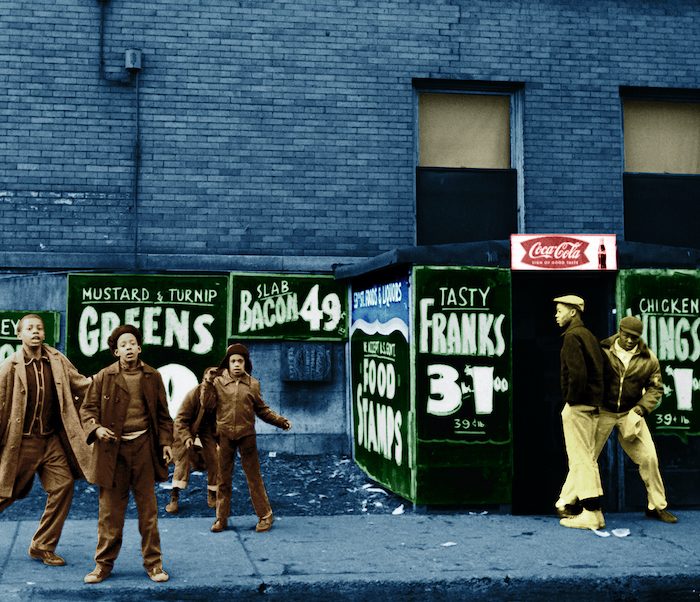
The photographs of Raeburn Flerlage capture the exciting blues scene in Chicago during the 1960s. Try the 3-2-1 technique to take a closer look at some of his images, then use your imagination to enter your favorite one and make music history! Share all of your creations on social media using the hashtag #CHMatHomeFamilies
Blues Bingo!
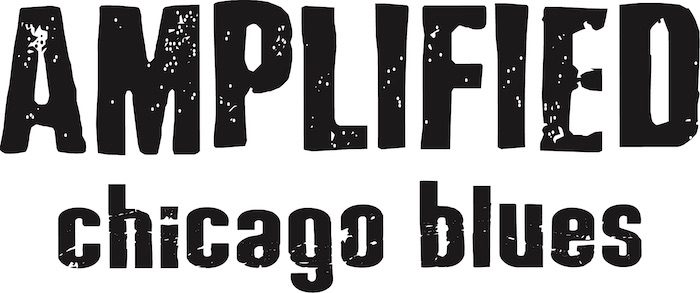
Use our images to make your own bingo cards all about blues music. Then have fun playing with your family and see how many times you can call out “Blues Bingo”! Share all of your creations on social media using the hashtag #CHMatHomeFamilies
Sing It!
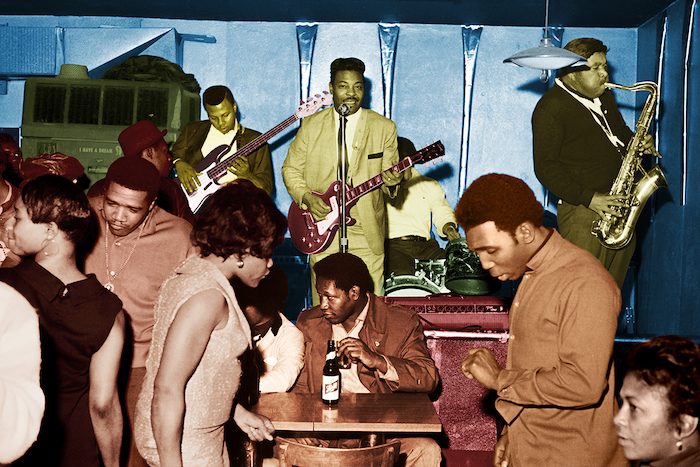
“Sweet Home Chicago” is a famous blues song about the city. It’s your turn to be a star: use our templates to write your own version of “Sweet Home Chicago” and sing your heart out! Share all of your creations on social media using the hashtag #CHMatHomeFamilies
Hood by Hood: Discovering Chicago’s Neighborhoods
This week’s challenge explores the rich history of Back of the Yards. When European immigrants came to Chicago, they faced many challenges. In response, they made choices that shaped the neighborhood of Back of the Yards, making it an essential part of the city’s identity. Explore images of the area, read a short article about its history, dig deeper via a short video about the neighborhood, listen and read along with a member of CHM’s education team using a short audio, and get creative as you design a star for the Chicago flag representing Back of the Yards.
Barrio por Barrio: Descubriendo los Vecindarios de Chicago
El reto de esta semana explora la historia del vecindario de Back of the Yards. Cuando los inmigrantes europeos y europeas del este llegaron a Chicago, se enfrentaron a muchos desafíos. En torno, tomaron decisiones que dieron forma al vecindario de Back of the Yard, haciéndolo una parte esencial de la identidad de la ciudad. Explora imágenes del vecindario, lee un breve artículo sobre su historia, investiga a través de un video corto sobre el vecindario, escuche y lea junto con un miembro del equipo de educación del museo usando un breve audio, y use su creatividad al diseñar una estrella que represente el vecindario.
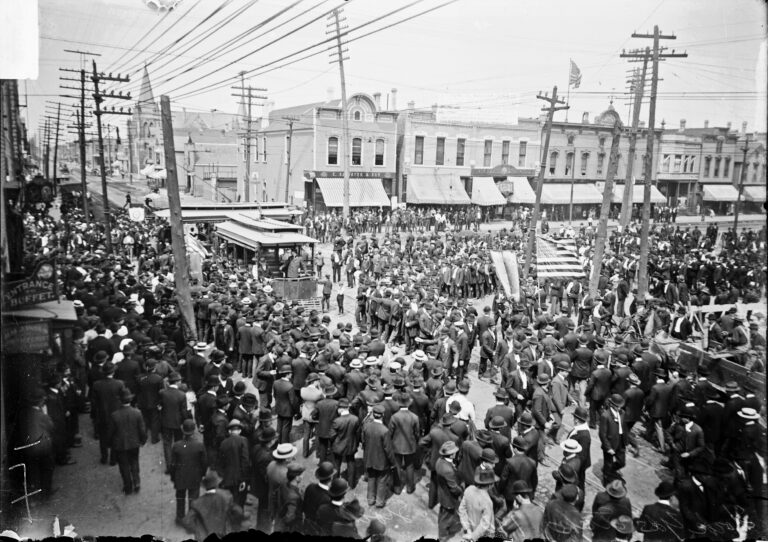
View of the intersection of South Ashland Avenue and West 47th Street crowded with men in the streets during the 1904 Stockyards Strike in Chicago, between July 7 and September 9, 1904. DN-0000883, Chicago Daily News collection, CHM
Back of the Yards is perhaps best known as the former home of Chicago’s meatpacking industry. In the nineteenth century, meatpacking emerged as a major industry and signaled the beginning of industrialization in Chicago. But working conditions varied at packinghouses, and the benefits of modern industry came with a price. In this week’s activities, discover how labor unions helped address these issues and what they are currently doing for workers during the COVID-19 pandemic.
El barrio Back of the Yards es quizás mejor conocido como el hogar de la industria del envasado de carne en Chicago. En el siglo XIX, el envasado de carne surgió como una industria importante y marcó el comienzo de la industrialización en Chicago. Pero las condiciones de trabajo variaban en las empacadoras y los beneficios de la industria moderna tenían consecuencias. Vea cómo los sindicatos ayudaron a abordar estos problemas y lo que están haciendo durante la pandemia de COVID-19 con las actividades de esta semana.
To mark what would have been the 108th birthday of Studs Terkel, Peter T. Alter, CHM chief historian and director of the Studs Terkel Center for Oral History, reflects on the memorable moments he shared with Studs at the Museum and Studs’s enduring cultural influence.
When I started working at the Chicago History Museum in 1999 as a public historian, I knew very little about oral history and museums. I did, however, know who renowned author, actor, journalist, oral historian, disc jockey, and television personality Studs Terkel was. The first Studs book I ever bought was “The Good War”: An Oral History of World War II (1984).
In the 1980s, one of my first trips with my newly minted driver’s license was to buy this Pulitzer prize-winning book at a local bookstore in western Illinois where I grew up. A few years later, I saw Studs speak at the Bughouse Square Debates, a celebration of free speech at Washington Square Park on the North Side.
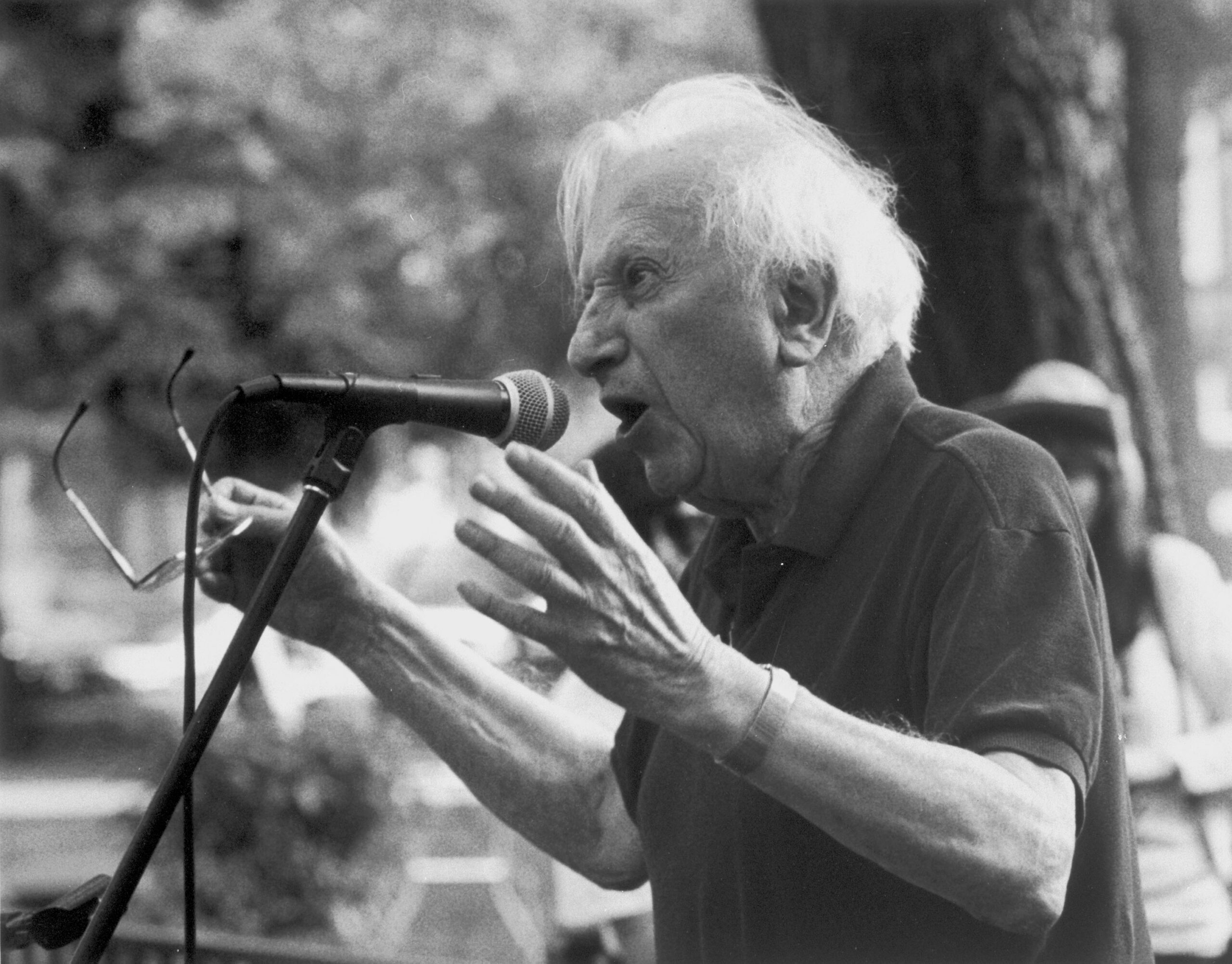
Studs Terkel making a speech in a park, Chicago, c. 1995. CHM, ICHi-034937
Jumping ahead to my first months at the Museum, I got to know Sylvia Landsman, my department’s volunteer. By that time, Studs was the Museum’s distinguished scholar-in-residence, a position he held from 1997 to about 2005. Sylvia met and became friends with Studs at CHM, and they bonded over the fact that they both attended the University of Chicago in the 1930s. In fact, he thanks her in his book Hope Dies Last: Keeping the Faith in Troubled Times (2004). Sylvia helped Studs mail packages and with other tasks. One day Sylvia wasn’t available, and I stood in for her when he needed help sending a book. For that simple assistance, he signed my copy of the “The Good War.”
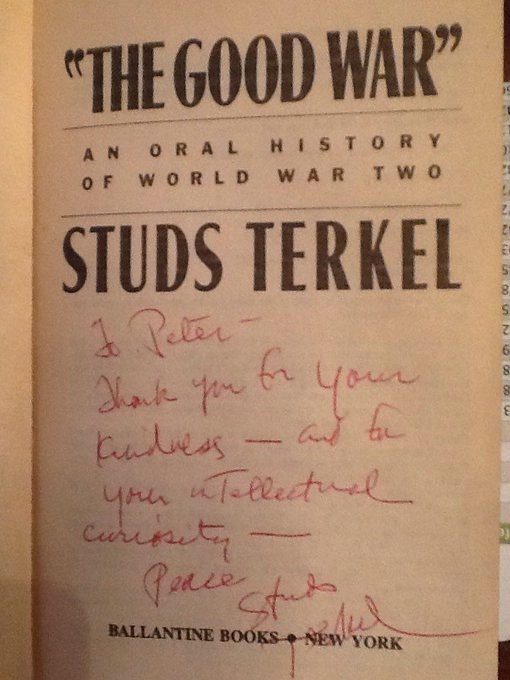
Studs’s message reads: “To Peter—Thank you for your kindness—and for your intellectual curiosity—Peace, Studs Terkel.”
Over the following years, I continued to be an eyewitness to Studs. I briefly met Mamie Till Mobley, Emmett Till’s mother, when Studs interviewed her at the Museum. Fourteen-year-old Emmett, a native Chicagoan, was lynched in Mississippi in 1955. I also saw Studs work with the young people of the Museum’s award-winning Teen Chicago project as they developed their own oral history initiative.
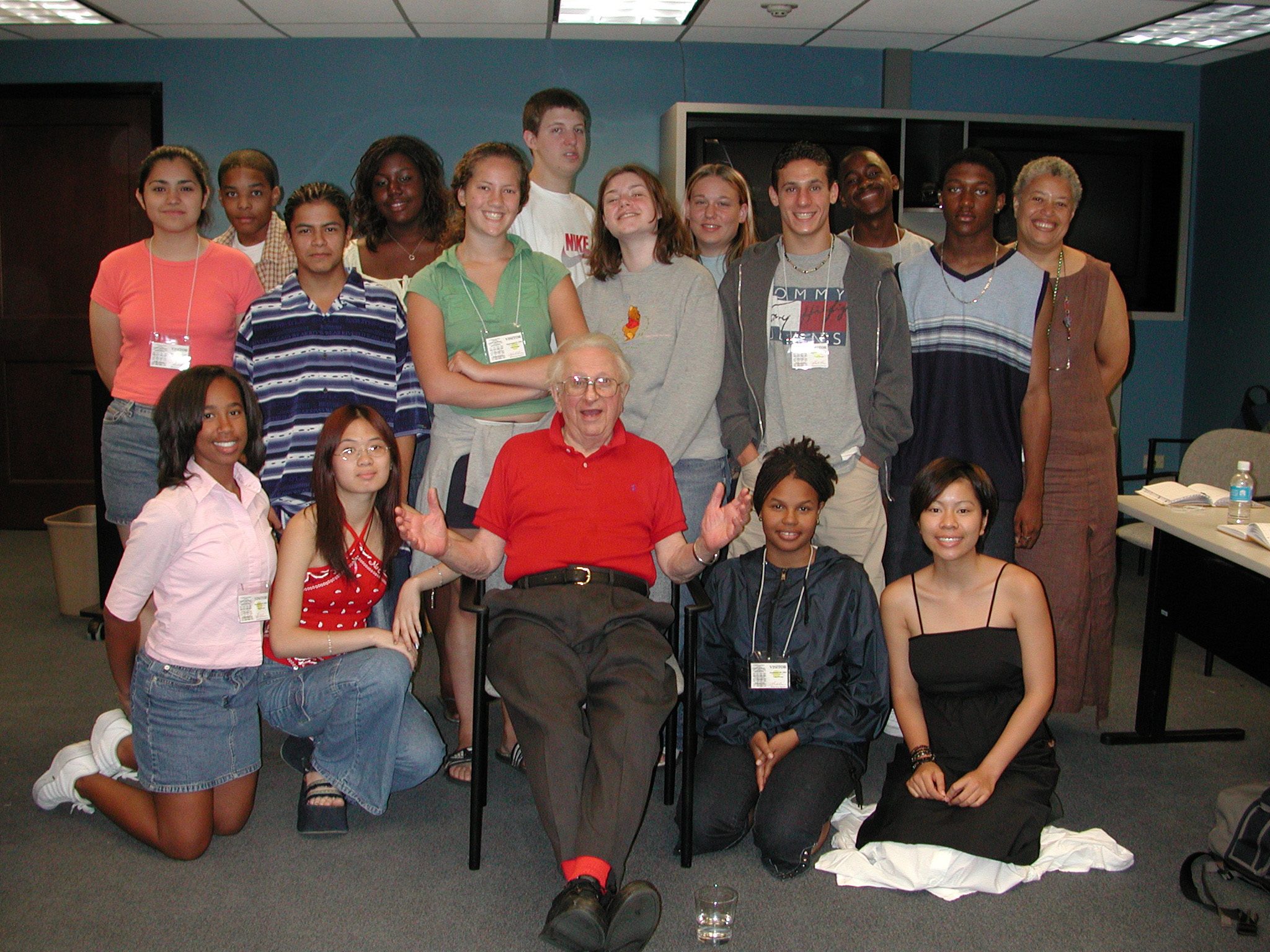
CHM’s Teen Council in 2004 with Studs (seated, center) wearing his trademark red socks.
Later, I started to listen to some of the digitized versions of his interviews. I quickly determined that my favorite one was his 1964 interview of Dr. Martin Luther King Jr. while the two of them sat at the “bedside” of Grammy award-winning gospel singer Mahalia Jackson at her South Side home. When I listen to Dr. King talk with Studs, I can imagine him with his ubiquitous open-reel recorder.
For five years, I worked as the Museum’s archivist in charge of its wonderful archival and manuscript collections, including Studs’s papers. When digging through his files, I found the transcript for his interview of Joe Ciardi, a well-known poet, whom Studs interviewed for “The Good War.” In the transcript, Studs explains the connection between that book and a previous book, Hard Times: An Oral History of the Great Depression (1970). While I was archivist, the Museum acquired the papers of Eliot Asinof, the author of the book Eight Men Out (1963), which details the 1919 Black Sox scandal. Of course, Studs plays sportswriter Hugh Fullerton in the 1988 movie version of Asinof’s book, which means Studs is also mentioned in the Asinof papers.
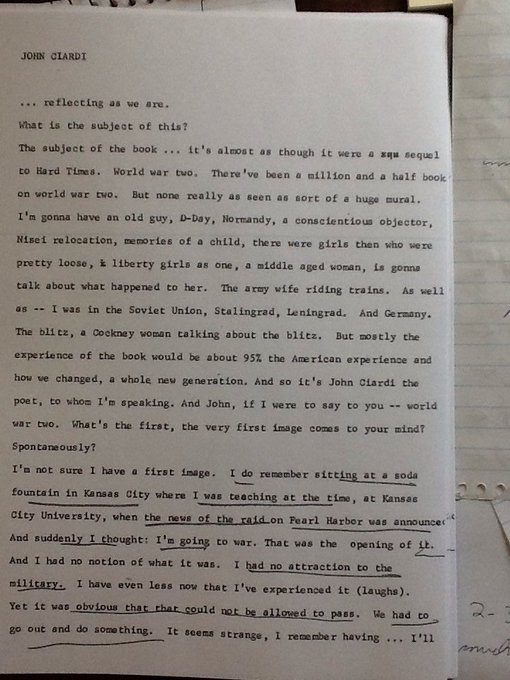
The transcript for the Ciardi interview with underlined phrases.
When I became the director of the Museum’s Studs Terkel Center for Oral History in 2015, I grew even more curious about his interviewing style. What I use in oral history training sessions is this wisdom from him: “So I think the gentlest question is the best one, and the gentlest is, ‘And what happened then?’” I am constantly using that in my own interviews as we carry forward Studs’s legacy through the oral history center’s collaborative community-based projects. I also enjoy wearing red socks every workday to acknowledge his famous footwear.
Naturally, these eyewitness-to-Studs moments continue even during the pandemic. My daughter Lily recently finished her first year as a vocal jazz major at Western Michigan University. What did she watch as she finished the second semester from home? Of course, she watched Ken Burns’s documentary series Jazz (2001), featuring multiple interview excerpts of Studs. In April, Friedrich Von Steuben Metropolitan Science Center history teacher Meghan Thomas emailed me about her students conducting pandemic-related oral histories to replicate Studs’s interviews in Hard Times. Just recently, I saw a reference to him in a Chicago Magazine article about the city’s labor history.
Over the years, dozens of people have told me their eyewitness-to-Studs-stories. Many remember listening to his program on WFMT or watching him on television. Others have ridden the CTA with him or waited at the same bus stop. A journalist told me about a chance encounter he had with Studs that changed his entire career trajectory. Some people remember Studs interviewing friends or family or meeting him at book signings and other events. Today, all of us can pick up his books or listen to his recordings. What are your eyewitness-to-Studs stories?